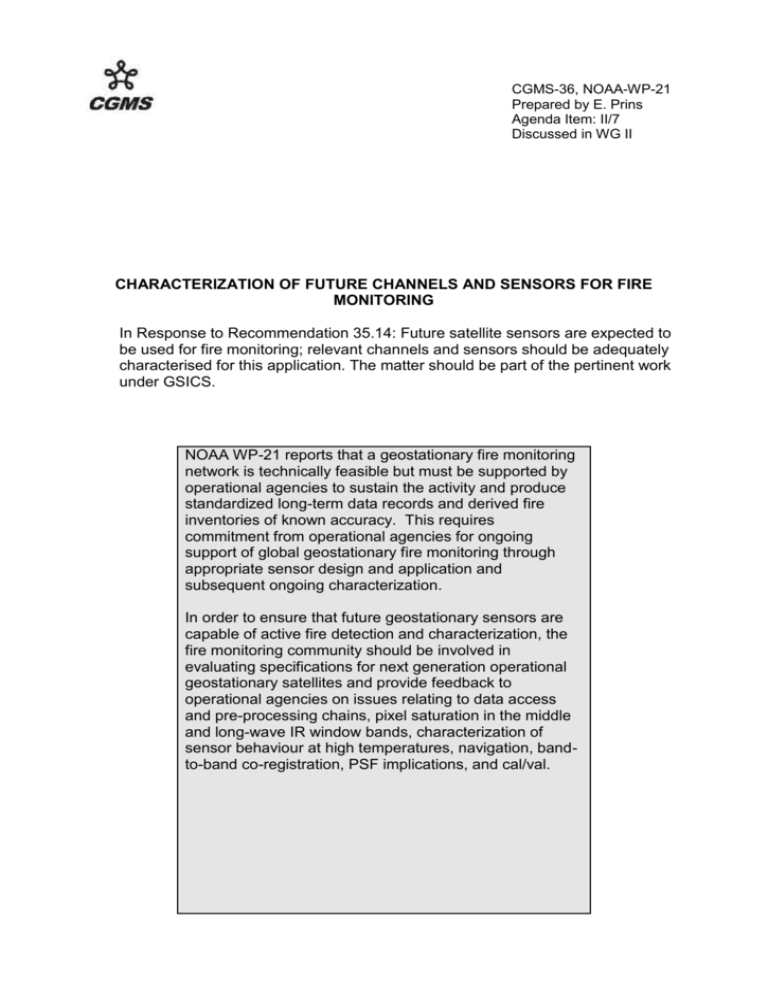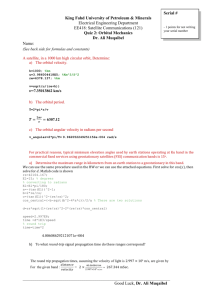Document Title
advertisement

CGMS-36, NOAA-WP-21 Prepared by E. Prins Agenda Item: II/7 Discussed in WG II CHARACTERIZATION OF FUTURE CHANNELS AND SENSORS FOR FIRE MONITORING In Response to Recommendation 35.14: Future satellite sensors are expected to be used for fire monitoring; relevant channels and sensors should be adequately characterised for this application. The matter should be part of the pertinent work under GSICS. NOAA WP-21 reports that a geostationary fire monitoring network is technically feasible but must be supported by operational agencies to sustain the activity and produce standardized long-term data records and derived fire inventories of known accuracy. This requires commitment from operational agencies for ongoing support of global geostationary fire monitoring through appropriate sensor design and application and subsequent ongoing characterization. In order to ensure that future geostationary sensors are capable of active fire detection and characterization, the fire monitoring community should be involved in evaluating specifications for next generation operational geostationary satellites and provide feedback to operational agencies on issues relating to data access and pre-processing chains, pixel saturation in the middle and long-wave IR window bands, characterization of sensor behaviour at high temperatures, navigation, bandto-band co-registration, PSF implications, and cal/val. CGMS-36, NOAA-WP-21 GLOBAL GEOSTATIONARY FIRE MONITORING: SENSOR AND DATA ISSUES AND RECOMMENDATIONS Elaine Prins1, Ivan Csiszar2, Wilfrid Shroeder3, Christopher Schmidt4, Louis Giglio5, Jay Hoffman4, Martin Wooster6, Jeffrey Reid7, Edward Hyer8, Yves Govaerts9 1 UW-Madison/SSEC/CIMSS Consultant, Grass Valley, CA 2 NOAA/NESDIS/STAR, Camp Springs, MD 3 ESSIC, NOAA/NESDIS/OSDPD/SSD, Camp Springs, MD 4 UW-Madison/SSEC/CIMSS, Madison, WI 5 Science Systems and Applications, Inc., UMD Dept. of Geography, College Park, MD 6 King's College London, Dept. of Geography, London, UK 7 Naval Research Laboratory, Marine Meteorology Division, Monterey, CA 8 UCAR, Naval Research Laboratory, Marine Meteorology Division, Monterey, CA 9 EUMETSAT, Darmstadt, Germany 1. INTRODUCTION Over the past 10 years the use of geostationary satellites for both diurnal fire detection and characterization has grown appreciably with applications in hazards monitoring, fire weather forecasting, climate change, emissions monitoring, aerosol and trace gas transport modeling, air quality, and land-use and land-cover change detection. Current (GOES-E/-W, Met-8/-9, MTSAT-1R, FY-2C/2D) and future (Indian INSAT-3D, Russian GOMS Elektro L MSU-GS, Korean COMS) geostationary platforms will enable nearly global geostationary fire monitoring. Several operational agencies (e.g. NOAA/NESDIS, EUMETSAT, UK Met Office, China Meteorological Administration, and India) plan to develop or expand existing geostationary fire detection and monitoring programs. NOAA/NESDIS and European satellite operators/users plan to implement a real-time global geostationary fire monitoring system in 2008 and 2009, respectively. These efforts also fit within the framework of GEOSS and fall under the GEO Tasks DI-06-13 and DI-06-09. Furthermore fire detection and characterization is a requirement for the next generation GOES-R Advanced Baseline Imager (ABI) and the Meteosat Third Generation (MTG) geostationary platforms. Current operational meteorological geostationary satellites were not specifically designed for fire detection, characterization, and monitoring and there is a wide range in the fire monitoring capabilities of current and near-term planned geostationary platforms. One of the goals of the GTOS Global Observation of Forest and Land Cover Dynamics (GOFC/GOLD) Fire Implementation Team is to foster the development and implementation of a near real-time operational global geostationary fire monitoring network using current and future geostationary platforms (Prins et al., 2001). Issues of sensor capabilities, data production and distribution, data standardization, intercomparison and calibration/validation are important underpinning activities for such a system to be viable. At the GOFC/GOLD Fire Monitoring and Mapping Implementation Team 2nd Workshop on Geostationary Fire Monitoring and Applications held at EUMETSAT in Darmstadt in December 2006 workshop participants felt it was important to establish closer ties with operational agencies through the Coordination Group for Meteorological Satellites (CGMS) in Page 1 of 10 CGMS-36, NOAA-WP-21 order to communicate requirements regarding sensor specifications, data preprocessing, product generation, and product distribution (Prins, et al., 2007). The following recommendation was sent to CGMS in October 2007 as presented in CGMS-35 EUM-WP-29. With the plans of operational agencies to produce real-time fire detection and characterization products, developers and implementation teams need access to detailed information on data pre-processing chains, calibration of the 3.9 and 11 µm bands at higher temperatures, and noise levels at these higher temperatures. More specifically there is a need for minimum and ideally no smoothing or filtering of information within the 3.9 µm band, and for detailed characterization of its behaviour beyond 300K and up to the saturation point. It is imperative that agencies provide detailed information on how observations in this channel are pre-processed and converted to level 1 radiance imagery from which fire products will be derived. In response to the GOFC/GOLD recommendation, the following recommendation was made by CGMS-35. Recommendation 35.14: Future satellite sensors are expected to be used for fire monitoring; relevant channels and sensors should be adequately characterised for this application. The matter should be part of the pertinent work under GSICS. This report expands on the issues presented in CGMS-35 EUM-WP-29 as input to the GSICS (Global Space-based Inter-Calibration System Working Group). The goal is to inform the GSICS of geostationary sensor and data issues that impact the fidelity of both current and future global geostationary fire products. Many of these topics are inherent to fire detection from polar orbiting satellites as well. 2. Global Geostationary Fire Monitoring: Sensor and Data Issues and Recommendations Diversity in operational meteorological geostationary satellite platforms around the globe make it difficult to set direct international hardware and data requirements for fire hotspot detection and sub-pixel characterization. Indeed, it is understood that major sensor requirements will likely be heavily influenced by other factors. In general, fire product fidelity can be most improved by increases in infrared channel spatial resolution and the maximum resolvable temperature in both the ~3.9 and ~11 µm bands, adequate characterization of these data, and the application of preprocessing methods that are appropriate for fire applications. Given the current hardware situation, with very diverse satellites making up the global geostationary constellation, the following topics represent the most crucial aspects to ensure consistent long-term high fidelity global geostationary fire products. Data access and pre-processing protocols In order to develop and maintain a global geostationary fire monitoring network the geostationary fire monitoring community needs consistent near real-time access (< 5 minutes after collection) to both current and future geostationary multi-spectral satellite data (INSAT-3D, Russian GOMS Elektro L MSU-GS, Korean COMS). Global access to these data at full spatial resolution and in level 1b format would be most preferable. Page 2 of 10 CGMS-36, NOAA-WP-21 Fire product data providers need access to navigated pre-gridded middle (~3.9 µm) and long-wave infrared (~ 11 µm) window data at original instrument resolution that have not been filtered or smoothed. The georectification process on some platforms smears out fire signals by averaging them with those of surrounding non-fire pixels. In this way resampling and regridding can act to mask the fire signal and impact both fire detection and characterization. Since fire detection algorithms are primarily contextual in nature, this reduces algorithm fidelity and significantly hampers noise and commission identification processes. If access to pre-gridded/pre-filtered data is not feasible operational agencies should provide detailed information on preprocessing chains that describe how observations are pre-processed and converted to level 1 radiances. Furthermore, for both the middle and long-wave infrared window bands it is vital that a protocol be established to address saturation of pre-aggregated detector samples in the pre-processing chain. This protocol must notify the user in the event the final pixel value is composed of one or more saturated sub-components. This could be achieved via a flag indicating the presence of pre-aggregated detector saturation. If this information is not made available, the fire-product data providers have no mechanism for identifying unreliable aggregated (or averaged) radiance values resulting in erroneous estimates of sub-pixel fire characteristics (e.g. estimates of sub-pixel fire temperature, size, and fire radiative power). In fact, in the absence of a detector saturation flag, all fire characterization will be suspect. At times, fire detection might also be impacted. In addition to the middle and long-wave IR window data, specific metadata are required for the proper interpretation of fire products and in particular for the proper comparison of data from different geostationary satellite systems. Most important are satellite and processing coverage regions, algorithm block-out zones associated with viewing geometry, atmospheric attenuation information, solar reflection contamination, biome type, and recent geo-location uncertainties. Also needed are consistent surface characterization maps and cloud/clear-sky masks that do not identify fire-emitted smoke as cloud. Ideally a mask is needed to report on the effects ranging from surface conditions to atmospheric transmissivity on satellite observations in the IR channels of interest. Spatial resolution Highest possible nominal pixel spatial resolution should be a priority for the middle infrared channels and the companion visible and thermal infrared bands used by most fire detection algorithms. The instrument’s spatial resolution has a direct impact on the minimum fire size that can be resolved by any given detection algorithm. The peak in middle infrared radiance produced by smaller sub-pixel fires is not always sufficient to produce a distinguishable signal from the background, introducing large omission errors in coarser resolution products. Schroeder et al. (2008a) demonstrated that the high temporal resolution data typical of geostationary satellites can help minimize the relatively large instantaneous fire detection omission errors that affect their derived products. However, important limitations are seen as a result of large pixel footprints, including, but not limited to the following. Page 3 of 10 CGMS-36, NOAA-WP-21 (i) Increase in latency. It can take several minutes or hours after ignition before a fire reaches the detection envelope of a coarse resolution sensor, significantly increasing the response time of the system. (ii) Fire characterization in terms of area and temperature can be significantly compromised. Using simulation data, Giglio and Kendall (2001) demonstrated that the application of Dozier’s (1981) approach to low spatial resolution pixels can introduce large and variable errors in retrieved fire size and temperature estimates. Using ASTER and ETM+ data to assess sub-pixel GOES based fire area retrievals, Schroeder et al. (in preparation) found similarly large and variable errors that could invalidate those estimates. (iii) Fire characterization in terms of radiative power (FRP) derived via the approach proposed by Kaufman et al. (1998) and followed by Wooster (2002) and Wooster et al. (2003, 2005) can also be indirectly affected by the pixel size. The interplay between sensor’s spatial resolution, point spread function (PSF) and the predominance of small sub-pixel fire lines can add up to a significant uncertainty in retrieved FRP (Schroeder et al., in preparation; Roberts et al., 2005). Large pixel footprints can result in fire lines located - in part or in full - away from the more responsive area near the center of the pixel, in theory generating under-represented fire energy information (Zhukov et al., 2006). This is further discussed in the section on the impact of PSFs. Pixel saturation and characterization of sensor behaviour at high temperatures Some geostationary platforms continue to be limited by low saturation levels in the middle-infrared window band impacting both fire detection and sub-pixel fire characterization. Figure 1 shows an example of the MTSAT-1R 3.7 µm band at 03:33 UTC on January 13, 2007. The low saturation in the 3.7 µm band results in large areas of saturation over hot, bright surfaces in Australia within several hours of local noon. Saturation continues to be a major limiting factor in MTSAT-1R fire monitoring capabilities, requiring conservative thresholds to eliminate false alarms associated with non-fire pixel saturation during peak solar heating. Although dedicated channels for fire monitoring may not be entirely feasible for operational meteorological satellites due to competing interests and requirements, the international remote sensing fire monitoring community has determined some minimum requirements that are deemed to be non-intrusive and are recommended as minimum standards for all current and future sensors in the global geostationary network. In order to limit saturation, the saturation temperature for instruments with a spatial resolution of 4 km should be at least 335-340K in the 3.9 µm band. For instruments with a 2 km spatial resolution, the saturation temperature should be at least 400K. Next generation geostationary planned missions (i.e. GOES-R and MTG) include 2 km pixel size and 400-450 K 3.9 µm band saturation temperatures for hemispheric mapping, and enhanced capabilities for regional fire mapping (Prins et al., 2008). Page 4 of 10 CGMS-36, NOAA-WP-21 Figure 1. MTSAT-1R 3.7 µm band at 03:33 UTC on January 13, 2007. The region highlighted in red is saturated due to the radiative signal from hot, bright surfaces unrelated to fire. Instruments with variable gain settings could be an alternative to fixed gain systems when multi-purpose missions limit the use of fire dedicated bands. Variable gain configuration could also optimize even fire dedicated channels improving their ability to map and characterize extreme fire events during moments of crisis (e.g., large high temperature wildland fires that can momentarily increase the frequency of saturated pixels) For sub-pixel fire characterization fire algorithms require well-calibrated data from the cold (for background and weak fire pixel signal assessment) to very hot brightness temperatures (for strong fire pixel signal assessment). If calibration and NEdT on the hot end for the 3.9 and 11 µm bands are not well characterized, sub-pixel characterization will be suspect on the hot end. Current and planned missions typically offer adequate calibration and noise information at lower temperatures (<330K) but do not adequately address calibration and NEdT on the hot end (>375K). The fidelity of global geostationary fire products can only be maintained with ongoing calibration of the 3.9 and 11 µm bands at higher temperatures and characterization of noise levels at higher temperatures. Page 5 of 10 CGMS-36, NOAA-WP-21 Figure 2. ETM+ band 7 (2.09-2.35 µm) and ASTER band 8 (2.295-2.365 µm) radiance grayscale images of a fire complex in Siberia on July 23 2002, centered approximately at 62.86N 125.67E. The ETM+ image shows near-zero radiance values over the most intense part of the fire; blooming and “spikes” along the scanline can be observed in the ASTER image Characterization of sensor behaviour at and beyond saturation is also needed. Experience with current and previous satellite sensors has demonstrated spurious sensor output when the incoming radiance exceeds the sensors’ saturation level. The spurious behaviour is a consequence of the folding of the output count value, resulting in either a physically interpretable (but incorrect) value below the saturation value, or in a near-zero value. This effect has been explicitly observed for AVHRR (Setzer et al., 1994), ASTER (Morisette et al., 2006) and ETM+ (Schroeder et al., 2008) (Figure 2). The spurious signal can also affect neighboring pixels due to sensor inertia and pixel cross-talk. In some cases saturated pixels can result in a “stuck bit” effect that results in a false elongation of a fire signature along a scan line. This was observed on the GOES-8 instrument and has also been documented in Met-8/-9 SEVIRI imagery in Europe and South America. Data navigation Geolocation accuracy to better than 1 pixel is highly desirable for satellite fire products. Active flaming fronts tend to be constrained to small areas and therefore occupy only a small pixel fraction of most current and future imaging instruments onboard polar orbiting and geostationary satellites. Recent validation studies using reference fire information based on higher spatial resolution data (e.g., ASTER and ETM+) to assess the quality of moderate-to-coarse resolution fire detection products demonstrated the importance of good navigation data [Schroeder et al., 2008a, b]. In particular, high quality pixel navigation was found to have an impact on the following. (i) Significantly reduce the manpower required to conduct comprehensive and systematic quality assessment and validation of moderate-to-coarse spatial resolution fire products. (ii) Enhance the potential for fire product inter-comparison and integration. (iii) Augment the usage of multi-source data towards creating higher confidence information on fire location and duration. Page 6 of 10 CGMS-36, NOAA-WP-21 (iv) Foster the development of third generation active fire detection algorithms relying on contextual tests applied to both space and time domains that can be used to identify fires and reduce false alarms associated with recent burning. (v) Foster the refinement of products which can benefit from input active fire data. Examples of major applications that use input active fire data include burnt area products and emissions models. Band-to-band co-registration The bi-spectral Dozier (1981) technique requires good band-to-band co-registration for the 3.9 and 11 µm bands. The larger the band-to-band co-registration distance, the greater the impact on the fire detection algorithm and bi-spectral estimates of sub-pixel fire size and temperature. In some instances sub-optimal band-to-band coregistration could impact fire detection commission/omission errors. This is especially true for low temperature fires and in the presence of clouds. In general, a co-registration error of no more than 10% is required for reliable retrievals of subpixel fire temperature and area (Shephard and Kennelly, 2003). Impact of Point Spread Function on fire detection and characterization Since fires are typically much smaller than the nominal footprint of a geostationary sensor, the location of the fire front within the pixel and application of a specific PSF impact the capability to detect and characterize the fire. The PSF parameterizes the diffraction effects and the energy received in the nominal geostationary footprint. Figure 3 provides an example of a simulated fire scene with temperatures ranging from background conditions to temperatures of 800K. The simulated fire scene is 50 times the resolution of the simulated satellite data in both directions. In this simplified example a Gaussian PSF and a step function PSF were applied to the simulated fire scene to determine the signature for each pixel. In the Gaussian case 87% of the signal came from the nominal footprint of the pixel, whereas the step function matches the nominal footprint. The location of the fire front within the pixel and the applied PSF type determine how the fire will be observed by the instrument. For a given pixel, when the fire is on the boundary of the footprint, the step function PSF temperature is warmer relative to the Gaussian temperature (blue in difference plot) and when the fire is near the center of the footprint sample, the Gaussian PSF is warmer than the step function (red in difference plot). In order to properly characterize sub-pixel fire activity it is important to evaluate and understand the impact of the point spread function on pixel observations. Calibration and Validation Activities To date geostationary fire product validation studies have been limited in scope due to the lack of adequate ground truth and limited funding and resources for aircraft validation studies in various biomes and under different viewing conditions. Routine cal/val should be based on comparisons of geostationary fire products with high resolution data (e.g. 30 m Landsat7 ETM+, Terra ASTER, Landsat Data Continuity Mission OLI - launch 2011) and should be automated (to the extent possible) Page 7 of 10 CGMS-36, NOAA-WP-21 Figure 3. Application of a Gaussian and a step function PSF to a simulated fire scene. In the Gaussian case 87% of the signal comes from the nominal footprint of the pixel, whereas the step function matches the nominal footprint. The location of the fire front within the pixel and the applied PSF type determines how the fire will be observed by the instrument. For a given pixel, when the fire is on the boundary of the footprint, the step function PSF temperature is warmer relative to the Gaussian temperature (blue in difference plot) and when the fire is near the center of the footprint sample, the Gaussian PSF is warmer than the step function (red in difference plot). (Morisette et al., 2005; Csiszar et al., 2006; Schroeder et al., 2008a; 2008b). Ideally, high spatial resolution instruments capable of detecting the radiative power of a fire without the influence of sensor saturation should be employed. This effort should be done in cooperation with the CEOS WGCV. Cross platform inter-calibration/validation is key especially with higher resolution instruments (such as MODIS/ASTER), but additional ground-truth validation is also needed. This could involve over-flights of fires by, for example, NASA Ames (UAV), data from USFS over-flights, and dedicated over-flights by fire-dedicated airborne systems (e.g. FIREMAPPER; Hoffman et al., 2004.). Page 8 of 10 CGMS-36, NOAA-WP-21 3. CONCLUSIONS AND FUTURE WORK A global geostationary fire monitoring network is technically feasible but must be supported by operational agencies to sustain the activity and produce standardized long-term data records and derived fire inventories of known accuracy. This requires commitment from operational agencies for ongoing support of global geostationary fire monitoring through appropriate sensor design and application and subsequent ongoing characterization. In order to ensure that future geostationary sensors are capable of active fire detection and characterization, the fire monitoring community should be involved in evaluating specifications for next generation operational geostationary satellites and provide feedback to operational agencies on issues relating to data access and preprocessing chains, pixel saturation in the middle and long-wave IR window bands, characterization of sensor behaviour at high temperatures, navigation, band-to-band co-registration, PSF implications, and cal/val. We also must foster improved communication between data providers, fire product developers and the user community to better meet current needs and prepare for the future. Many of the issues discussed in this document also impact fire detection by sensors flown on polar orbiting satellites. Further work is needed to fully document polar sensor requirements and to define specifications of a future integrated global geostationary/polar fire monitoring system. References Csiszar, I., Morisette, J., Giglio, L., (2006), Validation of active fire detection from moderate resolution satellite sensors: the MODIS example in Northern Eurasia. IEEE Transactions on Geoscience and Remote Sensing , vol. 44, no. 7, 1757-1764. Dozier, J. (1981), A method for satellite identification of surface temperature fields of subpixel resolution. Remote Sensing of Environment, 11, 221-229. Giglio, L., and Kendall, J., (2001), Application of the Dozier retrieval to wildfire characterization: A sensitivity analysis. Remote Sensing of Environment, 77, 34-49. Hoffman, J.W, Riggan, P., Griffin, S.A., Grush, R.C., Grush, W.H. and Pena, J. (2004), FireMapper 2.0: a multispectral uncooled infrared imaging system for airborne wildfire mapping and remote sensing. Proceedings of SPIE, Vol. 5152, 92 (2003); DOI:10.1117/12.510113 . Kaufman, Y. J., Justice, C., Flynn, L., Kendall, J., Prins, E. M., Ward, D. E., et al. (1998), Potential global fire monitoring from EOS-MODIS. Journal of Geophysical Research, 103, 32215−32238. Morisette, J.T., Giglio, L., Csiszar, I. , Justice, C.O., (2005), Validation of the MODIS active fire product over Southern Africa with ASTER data. International Journal of Remote Sensing, 26:4239–4264. Page 9 of 10 CGMS-36, NOAA-WP-21 Prins, E., Schmetz, J., Flynn, L., Hillger, D., and Feltz, J., (2001), Overview of current and future diurnal active fire monitoring using a suite of international geostationary satellites. In Global and Regional Wildfire Monitoring: Current Status and Future Plans (F. J. Ahern, J. G. Goldammer, C. O. Justice, Eds.), SPB Academic Publishing, The Hague, Netherlands, pp. 145 - 170. Prins, E. M., Govaerts, Y., Csiszar, I., (2007), GOFC/GOLD Fire Monitoring and Mapping Implementation Team 2nd Workshop on Geostationary Fire Monitoring and Applications – Executive Summary, EUMETSAT, Darmstadt, Germany, December 4 - 6, 2006. Prins, E., Schmidt, C., Hoffman, J., and Lindstrom, S., (2008), ABI Fire Detection and Characterization Algorithm Theoretical Basis Document, version 0.1, NOAA/NESDIS, STAR, 90 pp. Roberts, G., Wooster, M. J., Perry, G. L. W. , Drake, N. A., Rebelo, L.-M. and Dipotso, F. M., (2005), Retrieval of biomass combustion rates and totals from fire radiative power observations: Application to southern Africa using geostationary SEVIRI imagery, Journal of Geophysical Research, 110, D21111, doi:10.1029/2005JD006018. Schroeder, W., Csiszar, I., Giglio, L., Schmidt, C. (in preparation), On the use of fire radiative power, area and temperature estimates to characterize biomass burning via moderate-tocoarse spatial resolution remote sensing data. To be submitted to Journal of Geophysical Research. Schroeder, W., Prins, E., Giglio, L., Csiszar, I., Schmidt, C., Morisette, J., Morton, D. (2008a), Validation of GOES and MODIS active fire detection products using ASTER and ETM+ data. Remote Sensing of Environment, 112, 2711-2726. Schroeder, W., Ruminski, M., Csiszar, I., Giglio, L., Prins, E., Schmidt, C., and Morisette, J. (2008b), Validation analyses of an operational fire monitoring product: The Hazard Mapping System. International Journal of Remote Sensing, 29(20), 6059-6066. Setzer, A.W., and Verstraete, M.M., (1994), Fire and glint in AVHRR’s channel 3: A possible reason for the non-saturation mystery. International Journal of Remote Sensing, 15, 711-718. Shephard, M. W., and Kennelly, E. J., (2003), Effect of band-to-band coregistration on fire property retrievals. IEEE Transactions on Geoscience and Remote Sensing, 41, 2648-2661. Wooster, M. J. (2002), Small-scale experimental testing of fire radiative energy for quantifying mass combusted in natural vegetation fires. Geophysical Research Letters, 29(21), doi:10.1029/2002GL015487. Wooster, M. J., Zhukov, B., and Oertel, D. (2003), Fire radiative energy for quantitative study of biomass burning: Derivation from the BIRD experimental satellite and comparison to MODIS fire products. Remote Sensing of Environment, 86, 83-107. Wooster, M. J., Roberts, G., and Perry, G. L. W. (2005), Retrieval of biomass combustion rates and totals from fire radiative power observations: FRP derivation and calibration relationships between biomass consumption and fire radiative energy release. Journal of Geophysical Research, 110(D24311), doi:10.1029/2005JD006318. Zhukov, B., Lorenz, E., Oertel, D., Wooster, M.J. and Roberts, G. (2005), Spaceborne detection and characterization of fires during the Bi-spectral Infrared Detection (BIRD) experimental small satellite mission 2001-2004. Remote Sensing of Environment 100: 29-51. Page 10 of 10







